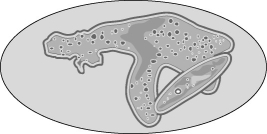You are given five test tubes, each containing an unknown protist, and your task is to read the following description and match these five protists to the correct test tube.
In test tube 1, you observe an organism feeding. Your sketch of the organism looks very similar to Figure 28.1. When light, especially red and blue light, is shone on the tubes, oxygen bubbles accumulate on the inside of test tubes 2 and 3. Chemical analysis of test tube 3 indicates the presence of substantial amounts of silica. Chemical analysis of test tube 2 indicates the presence of a chemical that is toxic to fish and humans. Microscopic analysis of organisms in test tubes 2, 4, and 5 reveals the presence of permanent, membrane-bounded sacs just under the plasma membrane. Microscopic analysis of organisms in test tube 4 reveals the presence of an apicoplast in each. Microscopic analysis of the contents in test tube 5 reveals the presence of one large nucleus and several small nuclei in each organism.

Figure 28.1
-Test tube 4 contains
Definitions:
Q17: In individual insects of some species, whole
Q26: In a hypothetical environment, fishes called pike-cichlids
Q30: Diplomonads, such as Giardia, contain two haploid
Q32: Which of the following is (are)problematic when
Q39: In Figure 30.1, the process labeled "6"
Q53: On the Pacific island of Guam, large
Q58: All things being equal, which of these
Q61: What is thought to be the correct
Q62: The first genes on Earth were probably<br>A)
Q71: What distinguishes a coelomate animal from a